Introduction
Ever wondered, what is 20 of 1800? Whether you’re calculating a discount, working on a school assignment, or just satisfying your curiosity, knowing how to determine percentages can be incredibly useful.
In this post, we’ll break it down in a way that’s easy to understand, even if you’re not a math whiz. By the end of this guide, you’ll not only have your answer but also a better grasp of how to calculate similar percentages on your own.
Let’s dive in!
Understanding Percentages
Before we get to the answer, let’s quickly go over what percentages mean.
A percentage (%) represents a fraction of 100. So, when you see “20% of 1800,” it means you’re looking for the portion of 1800 that makes up 20 parts out of 100.
The Simple Formula
To find a percentage of a number, use this basic formula: Percentage of a number=(Percentage100)×Total Number\text{Percentage of a number} = \left(\frac{\text{Percentage}}{100}\right) \times \text{Total Number}Percentage of a number=(100Percentage)×Total Number
Now, let’s apply this to our question.
Calculating 20% of 1800
Using the formula: (20100)×1800\left(\frac{20}{100}\right) \times 1800(10020)×1800
First, divide 20 by 100: 0.200.200.20
Then, multiply by 1800: 0.20×1800=3600.20 \times 1800 = 3600.20×1800=360
So, 20% of 1800 is 360.
That’s it! Simple, right?
Why Knowing Percentages is Useful
You might be wondering, “Why does this matter?” Well, percentages come in handy in many real-life situations. Here are a few examples:
- Shopping Discounts: If an item is $1800 and has a 20% discount, you now know you’ll save $360.
- Financial Calculations: If you’re investing money and earn 20% interest on $1800, you’ll make $360 in interest.
- Health & Fitness: If you burn 20% of your daily 1800-calorie intake during exercise, that’s 360 calories burned.
More Percentage Calculations
Now that you’ve got the hang of it, let’s try a few more:
- What is 10% of 1800?
(10100×1800)=180\left(\frac{10}{100} \times 1800\right) = 180(10010×1800)=180 - What is 50% of 1800?
(50100×1800)=900\left(\frac{50}{100} \times 1800\right) = 900(10050×1800)=900 - What is 5% of 1800?
(5100×1800)=90\left(\frac{5}{100} \times 1800\right) = 90(1005×1800)=90
The key takeaway? Just convert the percentage into a decimal by dividing by 100 and multiply by the total number.
Quick Mental Math Trick
Here’s a quick trick to calculate percentages without a calculator:
- Find 10% first: Just move the decimal one place left (10% of 1800 = 180).
- Multiply accordingly: Since 20% is double 10%, double 180 to get 360.
This trick works for most simple percentage calculations!
Conclusion
So, the answer to what is 20 of 1800 is 360. By now, you should feel more confident in calculating percentages in different situations.
Understanding percentages is a practical skill that makes everyday tasks—like shopping, budgeting, and even fitness—easier. With a little practice, you’ll be able to do these calculations in your head without breaking a sweat.
Happy calculating!
FAQs
1. How do I calculate any percentage of a number?
Use this formula: (Percentage100)×Total Number\left(\frac{\text{Percentage}}{100}\right) \times \text{Total Number}(100Percentage)×Total Number
2. What is 25% of 1800?
(25100×1800)=450\left(\frac{25}{100} \times 1800\right) = 450(10025×1800)=450
3. Can I do this without a calculator?
Yes! Find 10% first, then multiply accordingly. For example, 10% of 1800 is 180. So, for 20%, just double it to get 360.
4. Why are percentages important?
They help in financial planning, shopping discounts, investments, and even health calculations like calorie tracking.

